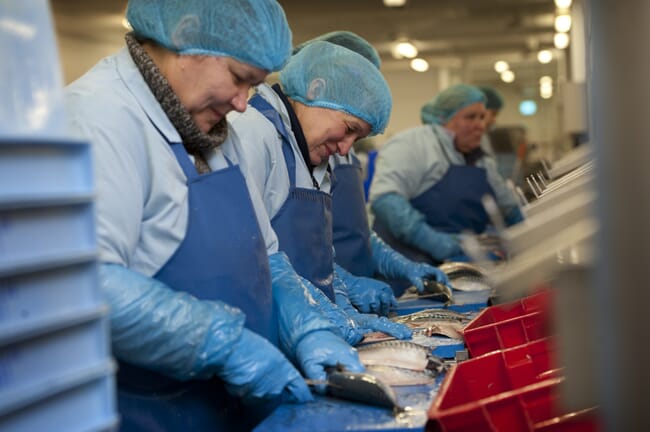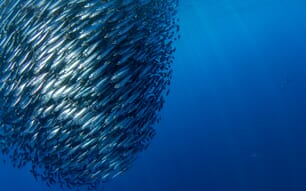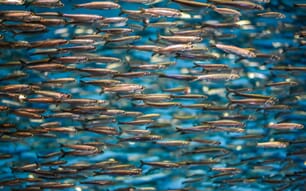
Fish trimmings can be salvaged and ground into fishmeal that can be used in animal and aquaculture feed © Seafish
Trimmings – also referred to as co-products – are viable offcuts (eg entrails, fins, scales, heads, tails) from other fish-processing activities. They can be salvaged and ground into fishmeal to be used in animal and aquaculture feed to reduce the burden on virgin meal from wild stocks.
The use of trimmings in this way represents a major circularity benefit to the salmon industry, making use of waste that is often disposed of at sea by fishing vessels or from processing plants. For this reason, salmon farmers are encouraged to incorporate high proportions of offcuts in their feed, and 50 percent of the salmon companies assessed by FAIRR showed progress by increasing their respective use of trimmings since the last financial year.
However, the potential volumes of trimmings available from the fishing sector are finite and are determined by fishing quotas set by various countries. Therefore, work needs to be done to increase the use and availability of trimmings already being produced from current fishing activities. A possible solution lies with the fishing industry, where co-products generated on factory trawlers could be stabilised, stored and landed.

An additional 10.5 million tonnes of trimmings could be used for FMFO production if all co-products are utilised © Farne
There would be significant cap-ex and op-ex involved in this transformation of the industry’s practices. The onboard storage room for whole fish would be reduced, impacting collection and refuelling schedules. Furthermore, once landed, trimmings would likely need to be transported large distances to the feed millers.
Despite the obvious challenges this transition poses, trimmings represent an untapped resource with huge potential. It has been estimated that an additional 10.5 million tonnes of trimmings could be used for FMFO production if all co-products currently produced from fishing practices are utilised. For context, this equates to almost double the volume of co-products currently used each year for FMFO. Furthermore, a Food and Agriculture Organisation (FAO) study estimated annual discards from by-catch between 2010 and 2014 at 9.1 million tonnes – 10.8 percent of the annual average catch overall during the same period – with 46 percent coming from bottom-trawling activities.
Despite the current state of play, there are cases where a far greater proportion of the fish landed are utilised, leading to a corresponding increase in the value generated. Iceland, for example, receives 30 percent more value from each cod caught than other developed nations through products such as omega-3 oil, roe and fish leather. The benefits of these efforts become more apparent when you quantify the proportion of whole fish currently used. Trimmings – mainly heads and guts – make up 37 percent of the weight of a demersal fish (eg cod and haddock), and in the case of tuna, only 50 percent of the weight is captured through the filleting process.
The volumes of material that are currently wasted within the seafood sector represent a massive inefficiency, epitomising the unnecessary damage caused to marine ecosystems, but also highlighting the potential opportunities innovation in this sector may provide.
For these reasons urgent work and investment are required to utilise this resource optimally, reducing waste and inefficiency whilst also relieving some pressure from the oceans.
* The FAIRR Initiative has just released its Oceans and Biodiversity Impact Phase 2 report on its collaborative investor engagement on sustainable aquafeed– after a coalition of 75 investors, representing over $16 trillion in assets, met with eight of the world’s largest salmon producers to discuss the biodiversity and climate risks in their feed supply chains. This series presents the main findings and trends that emerged from Phase 2.






